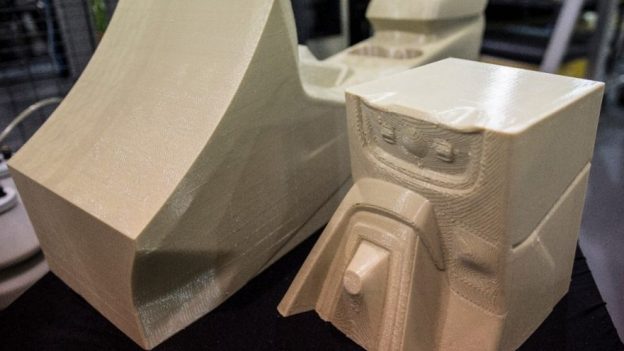One of the big pushes in manufacturing lately has been 3D printing. If you think the automotive industry is behind on the times, you might want to reconsider. Automakers certainly understand at least some of the benefits of this tech, and have even been leaders in using it.

A 3D printed part from Ford.
If current trends hold up, 3D printing will only become more prominent in the auto industry, thanks to its proven value, plus future innovations leveraging the tech.
Ford
Believe it or not, Ford has been using 3D printing to an extent since back in the 1980s. Call the automaker an early adopter, because back then most people had no idea such a thing existed. In fact, in 2017 the company exceeded 500,000 vehicle parts made using a 3D printer.
As the first automaker to try out the Stratasys Infinite Build 3D printer, Ford could be taking a big and bold step toward integrating 3D printing into its manufacturing processes.
This printer has the capability to create components and even tooling of any length or shape. It’s perfect for making a prototype vehicle, which can be an expensive and unnecessarily difficult task. In fact, setting up tooling for a prototype might take months, while 3D printing takes at worst a few hours. That would speed up vehicle development significantly.
Thanks to the Stratasys Infinite Build 3D printer, production downtime could be cut significantly. Broken tooling on an assembly line would be replaced quickly and efficiently if it can be printed then and there, instead of waiting hours or days.
In addition, the printer works well for components on low-volume models, including the Ford Performance vehicles, like the Ford Focus ST. Costs are excessive for setting up tooling to manufacture these components, making printing them far more financially attractive.
Ford sees increasing fuel efficiency requirements, both from the government and from consumers, as one big reason to use 3D printing. It claims that a printed spoiler could weigh less than half of a traditional cast metal spoiler.
Bugatti
The French automaker Bugatti is known for its excesses, and it’s bringing that kind of attitude to its approach with 3D printing.
As a first in the auto industry, Bugatti, with help from Laser Zentrum Nord of Hamburg, Germany, has printed a massive titanium brake caliper. The component is still in the testing phase, so full production isn’t moving forward yet.
Using printed titanium provides some performance benefits. Bugatti says the process shed as much weight as possible, while at the same time keeping torsional stiffness as a maximum. In a panic braking situation, caliper flex can increase stopping distances, making the difference between avoiding an accident and crashing.
For now, the Bugatti Chiron uses an aluminum-alloy brake caliper, which is created through a traditional forging process. The production front calipers weigh 4.9 kilograms each. With the 3D printed units, that weight drops to just 2.9 kilograms.
Creating the calipers involves four high-powered lasers melting titanium dust as it’s added by the printer. Again, time is a consideration. Bugatti says printing just one caliper takes 45 hours. Even though each layer of material cools instantly, allowing the next one to be laid, the calipers contain 2,213 layers of melted titanium dust. After the whole caliper has been printed, it must go into an oven at almost 1,300 degrees Fahrenheit, then is treated to ensure a smooth and bright finish.
Mini
Even Mini is getting in on the 3D printing fun. The British automaker, which is owned by BMW, recently announced a new program called Mini Yours Customized.
Already, Mini has a reputation for offering a level of personalization for mass-market cars you can’t get elsewhere. But this new program kicks things up a notch. Mini owners can order completely customized components, like a light cover or door sill with their name, a favorite phrase, or other design that’s unlike any other.
The secret to this next-level vehicle customization is 3D printing. It allows Mini owners to have a one-off part made for their car, in whatever color they like, with a design tailored to their preferences. Owners keep the factory components, so if they ever want to sell or trade in their Mini, they can remove the customized parts.
High-Volume Manufacturing
Despite its benefits, 3D printing technology hasn’t reached the point where it’s effective for high-volume production schedules. The main concern is time, since other methods can generate massive amounts of the same part in rapid order.
For now, it seems that 3D printing is a practice that will be reserved for exotic, low-volume vehicles. As the technology improves and printing speed increases, it could conceivably allow automakers to make quick changes to a mass-produced vehicle’s design, such as correcting a flaw that went undetected, or improving a layout based on customer feedback. It adds fluidity to the manufacturing process that is lacking right now.
Another application in the automotive industry is in the early stages: making parts for obscure cars. Jay Leno has said he uses a 3D printer to swap components on some of his old, unique vehicles. This technology has the potential to fulfill that unmet need in the market for the average car owner.
Essentially, as time marches on and 3D printers improve, their adoption in the auto industry will only increase.
Want to learn more about 3D printing? Fused Deposition Modeling (FDM) and PolyJet 3D Printing: Now and in the Future



